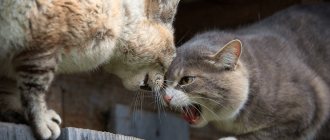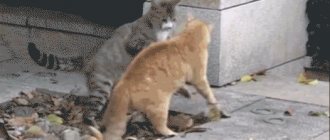6330Pavel
When there is a cat and a small child in the house, problems associated with their relationship often arise. It is not uncommon for a cat to hiss at a child for no apparent reason. Why she does this, you can answer after carefully observing her. - After what actions of the child does the cat hiss. It is only outwardly that it seems that she is doing it just like that. She definitely has her reasons to behave aggressively.
© shutterstock
A cat may hiss aggressively for several reasons.:
- jealousy,
- fear,
- protection of the territory.
Let's look at each of them.
Causes
People and cats belong to different biological species, so understanding each other is not always easy. However, if the slightest aggression appears, there is always a reason for this. After eliminating the reason or at least clarifying its nature, you can apply effective tactics that correct the pet’s behavior. That is why the question of why a cat rushes or hisses at a child is the starting point on the path to peaceful coexistence.
An animal hisses for two main reasons: fear and anger.
Reasons for a cat attacking a child
If you look on the Internet for recommendations on the topics “why does a cat hiss at a child” or “why does a cat attack a child and bite” on forums, the most common answer is: “the cat takes revenge on the child out of jealousy.” People generally tend to attribute human feelings and emotions to animals, although they are simply incapable of experiencing such multifaceted emotions as jealousy, envy, resentment, etc.
Cats obey instincts, not emotions, although they have a rather gentle and subtle mental organization and can be greatly impressed by events that seem insignificant to us humans.
First, you need to understand one important thing: a cat never attacks without a reason, another thing is that they are not always clear to people. Let's list the main ones.
Leadership in the cat family
When kittens switch to adult food and learn to defend themselves, they become independent and enter adulthood.
During this period, they cease to be cat children and become competitors for the attention of their owners, for the best tidbit, for territory. Hierarchy is very important in cats
When kittens switch to adult food, they become independent and enter adulthood.
At this age, it’s time to separate the cat and kittens and find a new home for the kittens. In special cases, you can try to endure and let them figure out for themselves who will be at what social level and themselves obey the subsequent rules established by the animals.
What cat teams are there?
There is an opinion that it is impossible to teach a cat any commands and that they are much more difficult to train than lions or tigers. However, practice shows that this is not entirely true, and that cats are quite capable of mastering simple commands: “come to me,” “stand,” “jump,” “sit,” and even “give me a paw.”
It is very important that the cat you are going to train is healthy, not scared, not stressed, and that the trainer is patient, caring and consistent in his intentions. From about six months of age, you can already teach your cat commands, following the basic principles:
- subsequence;
- regularity;
- only positive reinforcement (if, for example, your cat jumps over an obstacle, reward it with affection and treats for each such jump);
- no punishment for non-compliance;
- short-term (cats are usually tired from exercise for more than 30 minutes a day).
The most important thing that an owner must remember is that no training is worth the health and well-being of a cat.
To reward your cat, you can use dry food pellets from her main diet or wet food.
Territory threat
Cats perceive your home as their own, safe territory, where they are the rightful owner. If a small “stranger” suddenly appears in its possession, the animal experiences stress and perceives the child as a threat to its safety. In some cases, the cat will try to avoid the “alien”, and in others it will begin to take action to protect its space.
Reasons for misunderstanding
The cat attacks the owner: the main reasons and options for what to do
Pets, like people, are endowed with a sensitive personality. People and cats are different biological species. To achieve understanding between them, you need to try hard. One thing is clear, an attack does not happen without a reason, something preceded it.
A change in your pet's behavior can result from its abandonment. With the arrival of a baby, young parents often do not have enough time for their once beloved pet. He is deprived of affection, they forget to clean the tray during the time, and sometimes even to feed him. They are also not allowed to enter the room with a new family member.
Little angry kitten
You can discern the future aggressor in a kitten and rehabilitate it from the first days of acquaintance. If a baby, while playing, cannot use his teeth and claws half-heartedly and hunt for fun, then he is prone to aggressive behavior. Among the reasons why a kitten gets angry are early weaning from its mother and separation from littermates, which is why the baby did not receive proper education and did not learn to balance his strength in games with peers.
The kitten may also be prone to anxiety attacks, mood swings, and aggression towards people who seem dangerous to it. It takes a lot of time, patience and love to train him to behave correctly.
In addition, it is often the owners themselves who are to blame for the fact that the baby shows aggression. They do not stop the behavior of the pet when it bites fingers or attacks legs. Of course, while the kitten is small and has tiny teeth and claws, this may seem funny, but when the baby grows up, it will become no laughing matter at all.
Trying to get attention
What to do if a cat chews wires?
The cat perceives a lack of attention from the owner as a personal insult. She begins to raise her voice. Its timbre depends on what she is trying to say. Initially, it will seem like a newly born baby is crying.
If this does not help, the crying develops into a loud screeching siren, upon hearing which the owner will rush as fast as she can to the screamer in fear that something irreparable has happened. And he will be very surprised when he meets the calm, “I have nothing to do with it here” look of his pet.
Cats have other ways to attract attention. For example, throwing things off tables and cupboards, scratching doors, trying to open a closed door with a run. A reminder that the pet is hungry can be an empty bowl at the owner’s feet and the heart-rending cries of a hungry pet.
How to respond to a growl
Several rules will help relieve tension between you and your cat, the choice of which depends on the cause of the conflict:
- if aggression is associated with illness, take your pet to the clinic;
- when demonstrating a fighting spirit, wait 10–15 minutes until the pet calms down (it is better to go to another room during this time);
- after the cat has come to its senses, pet it, talk to it and treat it to something tasty;
- do not stop the cat from growling at your brood - this is one of the methods of education;
- if the cat’s fighting qualities are innate, just come to terms with this fact - you won’t influence the genes, so accept and love your bully for who he is.
Hissing is inherent in this breed
In some cases, a cat hisses because it is inherent in its breed. Let's say Siamese hiss due to the inherent behavior of this type of temperament. Some active breeds start to hiss because they don't get enough exercise. These are Abyssinian, Oriental, Cornish Rex and some others. Some furry breeds (Persians) hate it when they wash themselves and immediately start petting them. And there are hairless cats (Egyptian breed) - they hiss constantly, because hissing is part of their conversation, and does not necessarily mean aggression.
What to do if a cat attacks a child?
Safety is the key point in the relationship between a child and a cat, and one that worries parents the most. Cats and people belong to different biological species, so it can be very difficult for them to understand each other, even if we are talking about an adult, not to mention an unintelligent child. Let's try to figure out why a cat bites children and what to do in such cases?
Baby and cat in the same house
An infant and a cat often worry the baby’s parents not because of the fact of aggression, but because of fears that the pet may harm the child: it will suddenly scratch it, suddenly press it with its body, or suddenly infect it with something by licking the baby’s “milky” mouth. Here we can only advise one thing: watch. Don't startle the cat as soon as it approaches the cradle. It is important to find out her intentions in order to know for sure whether there is a danger or whether her fears are far-fetched. To minimize risks:
- do not leave toys in the baby's cradle if the cat or child is unattended;
- do not leave cookies or bottles of food inside;
- Do not allow your cat to sleep in the crib. But without obvious dissatisfaction. You just need to carefully shift the cat - she will understand that she still can’t sleep there. It is advisable to purchase a comfortable lounger or house; you can put a bottle of lukewarm water inside to attract your pet to a new place and make you forget about the cradle. The house must be placed on an elevation so that it is higher than the cradle;
- Take your cat to the vet to make sure that it is completely healthy and does not pose a danger to the baby.
Treatment of complications after a bite
Regardless of the size of the wound, the baby should be shown to a traumatologist. The surgeon will carefully examine the wound, clean and treat it, and apply a disinfectant bandage. If vaccination with tetanus toxoid was carried out a long time ago, the child is prescribed a tetanus vaccination. If the bite was inflicted by a stray cat or one whose owner cannot present a document on the animal’s vaccinations, the victim is vaccinated against rabies with anti-rabies serum according to the scheme.
If swelling or redness is observed, topical antibiotics for the cat bite are recommended. They are used in the form of an ointment:
- Gentamicin;
- “Levomekol”;
- Tetracycline;
- Levomycetinova.
In case of inflammation and suppuration of the wound, the doctor makes an incision and carefully cleans the wound surface from the accumulation of fluid and necrotic tissue. It is washed with antiseptics (Chlorhexidine or Miramistin) and cauterized with iodine. Be sure to apply a loose bandage, which should be changed daily. To prevent blood poisoning, treatment of a cat bite is supplemented by oral antibiotics:
- Azithromycin;
- Amoxicillin;
- Gentamicin K.
Attention! If sepsis is suspected, antibiotics should be prescribed by a doctor. He selects the drug based on tests and calculates the dosage individually. Self-medication is fraught with deterioration of the condition and can lead to serious consequences.
During antibiotic treatment, the child should be given probiotics, which help restore intestinal microflora and strengthen the immune system.
To heal, the wound is lubricated with Solcoseryl ointment 2 times a day. It contains components that accelerate tissue regeneration, preventing the formation of scars. Proper nutrition and vitamin complexes will improve the well-being of the little patient and support the body’s defenses.
Not jealousy, but boredom
Often, with the arrival of a child in a family, pets are relegated to the background. They are given less attention, they don’t play with them, don’t talk to them, aren’t allowed into the nursery where adults spend most of their time, or even forget to feed them or clean the toilet. Of course, such changes will not go unnoticed for the cat - the animal will feel abandoned, experience discomfort and may go the “wrong way” in attempts to attract attention.
Hisses at the owner
If the animal is not in pain, no one annoys it, aggression towards the owner may be due to the fact that it was severely punished by him. Even a loud cry is perceived negatively by a cat. She will remember who yelled at her and will hiss at that person. You can forget about the incident, but cats often don’t forget this.
To maintain a good relationship with your pet and peace in the house, you should treat everyone who lives nearby with respect.
You cannot hit cats; they will not forget aggression and will perceive it as a threat, as an attack. And in turn, the animal will behave accordingly - move away from the person, hiss and snort in response.
But a cat can hiss at its owner out of surprise or fear. For example, someone approached her silently, and hissing becomes natural behavior for the pet at such a moment. Just as a black cat scares people, it can also experience fear at some moments.
What does a cat express when it hisses and growls?
Communication between animals, both wild and domesticated, mainly occurs through various sounds, postures, and movements. Typically, a domestic cat experiences only positive emotions and, accordingly, behaves affectionately and purrs. When he experiences negative feelings, his behavior changes dramatically. By finding out why your pet's mood has worsened, you can easily change the situation for the better.
shutterstock
To understand why a cat growls and hisses, you should know about the main reasons for aggression in animals. These are:
The desire to warn a person about your bad mood or dissatisfaction. Domestic cats for the most part do not like playing with small children. Exceptions occur in cases where the parents taught the child how to play with the furry correctly. Namely, be affectionate with him, stroke him, understand that the cat is a friend and you cannot offend him. Sometimes the cat growls, warning of the danger threatening its owner. There are cases when a pet was the first to smell the gas and with its behavior saved the lives of its owners. The cat also growls loudly, sensing the approach of bad weather or an earthquake. It turns out that a cat can even help a person with its negative behavior. The main thing is to understand it in time. Fear is another common cause of cat aggression. An animal can be afraid of many things: from a new thing in the house to a stranger. Even an owner suddenly jumping out from around a corner can greatly frighten a pet. At the same time, a calm, generally non-aggressive cat hisses and growls in surprise. Human fear is no less common. It is relevant for a cat picked up from the street. The fear of people can last a lifetime, even if you pick up a small kitten. It is possible that he will only allow a select few to approach him, and perceive the rest as a threat
The cat will not be wild, but it will never stop behaving cautiously with new people. Instinctive defense of property. This category includes the cat’s area of residence, favorite resting and sleeping places, toys, food bowl and other items that the animal considers personal
It is not surprising that, in defense of his cat, he growls and hisses, thus scaring away everyone who encroaches on his personal space and things. Resentment or dissatisfaction. The domestic cat experiences these feelings in different situations. All furry owners are familiar with the offended look of a pet whose tail has been stepped on; this happens very often. Naturally, the cat will want to express his grievance, so he begins to hiss and sometimes growls at the offender. Dissatisfaction (frustration). Small kittens that are abruptly separated from their mother are most susceptible to it. They do not receive enough maternal care and milk, as a result of which they suffer emotionally. Frustration is easy to recognize. In this case, the small kitten is reluctant to make contact, but attacks the food, growls, hisses, and tries to eat everything as quickly as possible. He can also rush around the room, screaming and meowing loudly. An adult cat, in a state of dissatisfaction, becomes nervous and growls at its owner for no reason, although it perceives him as a friend. Manifestation of predatory instincts. Often, during the game, the cat gets so carried away that the basic instincts of his ancient predatory ancestors awaken in him. Then the cat growls, letting his wild nature take over. Just slow down the pace of the game, he will calm down and will be a cute pet again. Pregnancy. A cat in an interesting position needs peace, rest and maximum care. The changes occurring in her body greatly influence her behavior, and changing hormonal levels sometimes provoke frequent mood swings, increased sensitivity, and nervousness. All this leads to various manifestations of character and becomes the reason that she growls in response to certain actions of familiar and unfamiliar people.
It turns out that finding out why a cat growls and hisses will not be difficult if you take a close look at the general situation, the environment and the attitude of people towards the cat.
Through the eyes of a cat and the eyes of a child
Animal psychologists name three main reasons why small children and cats cannot find a common language: fear, jealousy and defense of territory. Whatever the reason for starting a military campaign, the basis for solving the problem should be love and patience, even if the cat attacked the child for no apparent reason or the child hit the cat, seemingly for no reason. However, it is important to get to the root cause in order to know in which direction to move.
- Fear
Understanding why cats are afraid of children is not that difficult. Babies are noisy, fussy, unpredictable and eccentric creatures. The cat loves peace and quiet, values privacy and respects boundaries when communicating. Not every pet is happy when a stranger wants to pat her behind the ear. What can we say about a child who, despite all the signals given, stubbornly refuses to back down! If a domestic cat bit a child, most likely, before taking extreme measures, she made it clear for a long time and persistently that she did not need close contact: she flattened her ears, bristled her whiskers, sparkled her eyes and beat her tail on the floor. But any patience comes to an end, and teeth come in. The baby, having first “become acquainted” with teeth or claws, remembers the lesson for a long time. Now the cat is not a funny soft toy with batteries, but something evil and dangerous, capable of causing pain. In some cases, the child deliberately torments the cat, taking revenge on her for her reluctance to communicate and remembering the bite or scratches. This is the case when fear takes an aggressive form: the best defense is attack. This also includes a defensive reaction when a child hits a cat with a bucket just because it is approaching him. Perhaps the pet is interested in the squeaker or wants affection, but once upon a time a cat scratched the child, and he remembers it very well. In this case, it is important to explain to the child why the cat is attacking. Talk about the pain that the baby causes with careless movements. Be sure to explain that the cat is also a member of the family, that we love it too, since it protects our house from arrogant mice who would certainly take away your candies and toys if it were not for the cat. And she is very brave and strong: “Do you remember how painful it was when she scratched you? Not a single mouse will pass!
- Jealousy
Kids quickly get used to the fact that everyone, from their mother to an unfamiliar aunt from the store, is delighted and touched by them. And then suddenly some cat dared to show her claws! It’s both scary and offensive - we need to show her who’s boss. In turn, a cat, accustomed to attention, feels abandoned when a child appears in the house. This means you need to drive out your competitor. This is the case when a cat in the house and a child can live in peace if adult family members find time to communicate on equal terms with both the baby and the pet. Joint games and natural science “lessons” for the child help: “Look how high the cat can jump! Do you know why she needs a mustache and a tail? Do you know why she has such amazing eyes?” Replacing jealousy with lively curiosity is a great option.
- Territory defense
One of the reasons why a cat hisses at a child is to defend its territory. While the baby spends all the time in the cradle or in the arms of the mother, the cat is calm and does not perceive him as a competitor. But when the child begins to crawl, grab her “prey,” touch bowls and crawl into her favorite house, it’s time to act. The cat begins to educate the baby, showing him that some objects and places are her property.
Often a kitten and a child in the house fight over the baby's toys. Not all children know how to share and not everyone easily agrees to have a cat lie on their bed, take their favorite toys with its teeth and lie on the lap of their beloved mother. In this case, there are two decisions: everything is shared or yours and mine. The first option is simpler: we arrange joint games, under supervision we allow the baby to touch what the cat considers to be its property, teaching it to calmly react to intrusion. The second option: show the child what belongs to the cat and explain that it should never be touched (bowls, toys, bedding, etc.). The difficulty is that it is almost impossible to teach a cat not to react to children’s toys, so it is better to educate from the position of “don’t be greedy.” Universal advice without reference to the reason for the “confrontation”: in order for the baby to change his anger to mercy, shift some of the caring responsibilities to him cat Explain that he is already big and almost completely grown up, that the cat needs his support and care: “let’s pour water for Bead, let’s feed him, let’s brush his hair.” Together you can make a toy for your pet or sew her a warm mattress. The child, feeling strong, responsible and grown-up, perceives the cat as a creature that needs to be protected and protected, and therefore treated with care and attention. In order for the cat to react more calmly to the child, you need to control the baby’s actions. In addition, it is important to provide peace for the cat by installing a house somewhere higher where the child cannot reach. Punishments will make the situation worse, so it is important to be patient when disciplining a mustachioed aggressor without physical force.
Jealousy
In a situation where the cat lived in the house even before the birth of the child, accustomed to everyone's attention, she may feel abandoned. In this regard, the cat will try to drive away the competitor, which is why it hisses.
If the kitten was adopted after the birth of the baby, jealousy may appear on the part of the younger owner. Aggressive actions will then appear on his part; he may hit the cat for no reason. In response to them, the cat will hiss aggressively.
To eliminate such “contractions,” adults need to set aside time to communicate on an equal basis with the baby and pet. A way out of this situation can be playing together with a kitten, during which it is appropriate to direct the child’s attention to the positive qualities of the pet. For example, emphasize to him the cat’s ability to jump high. You can ask your child if he knows why a cat needs a mustache. The best way out when a child is afraid of a cat is to replace his jealousy with curiosity. True, this is only possible if he is already three years old. Otherwise, it will be difficult to explain why the cat hisses at him.
Hissing at other animals
The mustachioed purr can demonstrate dissatisfaction and aggressive behavior towards its relatives, kittens or other pets.
For adult cats and female cats
All representatives of the cat family are considered loners. Even when living in the same house or apartment with people, your pet wants to feel independent.
Therefore, the cat hisses at the new cat, trying to drive the stranger out of the territory that it considers only its own. Females are more jealous of their owner and everything that surrounds her. Adult males perceive new neighbors more calmly, taking them under their protection. But other males are treated as competitors.
Aggression and manifestations of discontent are a defensive reaction that lasts until the adult individuals come to terms with living together and divide the territory in half. A person’s task is to make friends with pets with the least loss for both parties.
For kittens: ours and others'
Most often, sterilized individuals who have never given birth hiss at other people's kittens. They are afraid of strange creatures that smell of milk and another female.
A mother’s emotions towards her babies can be caused by various reasons:
- Mom calms the children down and lets them know to be quiet and not attract attention.
- The female trains the babies, teaches them aggressive behavior so that in the future they can stand up for themselves.
- If the kitten is picked up too early, its smell will become foreign to the mother.
- A cat hisses at a kitten if he bites her nipple painfully while feeding or if she has run out of milk.
Sometimes a mother drives a weakened baby away from her in a similar way, not wanting to waste milk on him. This is how the natural instinct of natural selection manifests itself. The female does not want to waste her energy on him. Mothers are also aggressive towards older children, considering them competitors.
On other pets
The perception of other animals unexpectedly appearing in the house may not be immediately positive. Screams, hissing and growling will inevitably accompany the first meeting of new neighbors. Owners with mustaches especially cannot stand dogs.
Even if the dog does not pretend to seize someone else's territory, the cat will continue to react negatively to his presence. Relations between them will improve over time, but only a person can speed up the process of reconciliation. To do this, the owner must pay enough attention to each pet, taking responsibility for raising both.
What does a cat express when it hisses and growls?
Communication between animals, both wild and domesticated, mainly occurs through various sounds, postures, and movements. Typically, a domestic cat experiences only positive emotions and, accordingly, behaves affectionately and purrs. When he experiences negative feelings, his behavior changes dramatically. By finding out why your pet's mood has worsened, you can easily change the situation for the better.
shutterstockTo understand why a cat growls and hisses, you should know about the main reasons for aggression in animals. These are:
The desire to warn a person about your bad mood or dissatisfaction. Domestic cats for the most part do not like playing with small children. Exceptions occur in cases where the parents taught the child how to play with the furry correctly. Namely, be affectionate with him, stroke him, understand that the cat is a friend and you cannot offend him. Sometimes the cat growls, warning of the danger threatening its owner. There are cases when a pet was the first to smell the gas and with its behavior saved the lives of its owners. The cat also growls loudly, sensing the approach of bad weather or an earthquake. It turns out that a cat can even help a person with its negative behavior. The main thing is to understand it in time. Fear is another common cause of cat aggression. An animal can be afraid of many things: from a new thing in the house to a stranger. Even an owner suddenly jumping out from around a corner can greatly frighten a pet. At the same time, a calm, generally non-aggressive cat hisses and growls in surprise. Human fear is no less common. It is relevant for a cat picked up from the street. The fear of people can last a lifetime, even if you pick up a small kitten. It is possible that he will only allow a select few to approach him, and perceive the rest as a threat
The cat will not be wild, but it will never stop behaving cautiously with new people. Instinctive defense of property. This category includes the cat’s area of residence, favorite resting and sleeping places, toys, food bowl and other items that the animal considers personal
It is not surprising that, in defense of his cat, he growls and hisses, thus scaring away everyone who encroaches on his personal space and things. Resentment or dissatisfaction. The domestic cat experiences these feelings in different situations. All furry owners are familiar with the offended look of a pet whose tail has been stepped on; this happens very often. Naturally, the cat will want to express his grievance, so he begins to hiss and sometimes growls at the offender. Dissatisfaction (frustration). Small kittens that are abruptly separated from their mother are most susceptible to it. They do not receive enough maternal care and milk, as a result of which they suffer emotionally. Frustration is easy to recognize. In this case, the small kitten is reluctant to make contact, but attacks the food, growls, hisses, and tries to eat everything as quickly as possible. He can also rush around the room, screaming and meowing loudly. An adult cat, in a state of dissatisfaction, becomes nervous and growls at its owner for no reason, although it perceives him as a friend. Manifestation of predatory instincts. Often, during the game, the cat gets so carried away that the basic instincts of his ancient predatory ancestors awaken in him. Then the cat growls, letting his wild nature take over. Just slow down the pace of the game, he will calm down and will be a cute pet again. Pregnancy. A cat in an interesting position needs peace, rest and maximum care. The changes occurring in her body greatly influence her behavior, and changing hormonal levels sometimes provoke frequent mood swings, increased sensitivity, and nervousness. All this leads to various manifestations of character and becomes the reason that she growls in response to certain actions of familiar and unfamiliar people.
It turns out that finding out why a cat growls and hisses will not be difficult if you take a close look at the general situation, the environment and the attitude of people towards the cat.
Causes of violence against animals
Why does a child mock insects and animals? There may be several reasons.
- I don't know what I'm doing.
This can happen to young children who do not understand that animals hurt and that they can even die. Here's an example. A three-year-old child walks slowly along the sidewalk and suddenly - once - steps on an ant, and even laughs at the same time. Well, of course. He decided to play catch-up with the bug and quickly caught it. This is a real victory! Here you need to explain to the tormentor that the bug is also in pain and you can’t do it like him. But if the baby continues in the same spirit, you should be wary and try to understand his motivation. - What's inside?
For many children, a bug or a worm is the same as Lego, which can be disassembled and assembled. But this is even more interesting! The bug resists and twitches. Children “disassemble” the bug into parts like cars they play with. Sometimes they deliberately kill insects because they do not yet understand what life and death are. It's a game for them. Hit the caterpillar with your palm and see whether it crawls or not. - And I can do that too (I will)
. Very often, children mock insects, fearing that they will be considered timid. They do this “for the company” in order to be like everyone else. Sometimes children of school and preschool age try to assert themselves. If they are constantly pressured by their parents, or they experience persecution at school, tormenting an insect, dog or cat, they “let off steam”, the negative emotions that have accumulated in them. But often the parents themselves are to blame for this. The child repeats the behavior of his elders by throwing the cat out the door or tying up the dog. - I am not afraid of you
. Sometimes (relatively rarely) a child begins to take revenge on animals because they once scared him, bit him, or scratched him. It’s as if he wants to prove that he is stronger and can stand up for himself. And the second time you won’t end up in a situation that happened earlier.
If a child knows that he is hurting another being, but continues to do so, he should consult a psychologist.
But first you need to reconsider your behavior. Perhaps the reason lies precisely in the attitude of the parents towards him, and your child needs:
- in praise;
- feeling of security;
- emotional contact with parents;
- more relaxed environment.
Does your cat hiss and lunge?
For every owner of a furry friend - a cat, it is not uncommon for the pet to start hissing. At the same time, the eyes sharpen, the ears are pressed to the head, the back is arched, the mouth opens slightly and a hissing sound is heard. In this case, the cat is said to hiss.
What does a cat hiss mean?
Encroachment on territory. Having noticed another four-legged animal on its territory, for example, when a cat and a dog meet, the first begins to hiss threateningly. Having met an enemy larger, higher and possibly stronger, he uses an elementary psychological technique - intimidation. It works on most animals.
Harassment from others. A pet can “say” its word if you start pestering it. If there is a child in the house, then from an early age it is better to instill in him respect for his smaller brothers, for their territory and interests.
Protecting your offspring. It is this feature of behavior that is observed when a cat becomes pregnant; it is often confused with aggression, although this is just a natural instinct to protect the kittens that are about to be expected. It is worth noting that a furry friend may hiss even after giving birth at first, when he will be very afraid and worried about his offspring. Only after a certain period of time, when the young mother’s confidence in protecting herself and her family has strengthened, will she stop behaving aggressively.
Why does a cat hiss and not growl?
Where did it come from that the furry four-legged creatures chose hissing as a threatening factor, and not growling like dogs. The fact is that, unlike dogs, which are pack animals, these animals do not need a hunting partner. And, as you know, to be an excellent hunter, you need to adopt the habits of other specialists
Source
Fear
The enmity between cats and children is not difficult to understand. Animals prefer a quiet, calm environment and are kept to respect territorial rights. Young children are usually eccentric, fussy and very noisy. The child, despite the signals given, behaves aggressively and noisily, thereby causing fear in the animal, bordering on horror. In such a situation, a cat will not only hiss or growl, but may also rush at a person. In addition to the noise, the cat may be embarrassed by the unfamiliar smell of the baby; in order to remove these negative emotions, you need to gradually accustom it to it.
© shutterstock
It is useful if the child plays with the pet with shared toys specially designed for this occasion . If a cat accidentally or intentionally scratches a child, he will remember it for a long time. Now he knows that the animal is not a toy, and will be afraid of it. After such an incident, he often takes revenge on the animal for its reluctance to communicate and the pain caused. The best form of defense is attack. Therefore, the baby can just hit the kitten. It is important to explain to the child that doing this is bad, that the pussy also hurts. Try to explain to him why the cat attacks. After a certain time, the animal will cease to be afraid of the child, and therefore hiss and rush at him.
Photophobia in cats
Why does a cat hide kittens - take them to different places and what to do
With photophobia, the cat will also look for a secluded dark place and squint at the light, as it irritates the eyes and hurts the cat. This may be an alarming symptom indicating the following conditions:
- eye injury (mechanical, chemical, thermal);
- allergic reaction;
- stroke;
- concussion;
- rabies.
Eye injury in a cat
Note! If the animal is not vaccinated and roams freely on the street, then photophobia may be a symptom of rabies. Rabies is deadly for animals and people, mortality rate is 100%
At the first symptoms (photophobia, hydrophobia, drooling, aggression), you must consult a veterinarian! It is also necessary to avoid as much physical contact with a potentially infected cat as possible. Rabies is transmitted through the bite of a sick animal when saliva enters the bloodstream.
Excessive and inappropriate touching
Children under two years old reflexively grab everything with their hands, including cats. The idea of someone else’s body as one’s own, that is, the ability to transfer one’s own sensations to other living beings, is not immediately formed in children. You want to touch soft fluffy cats endlessly, so it’s not surprising that children show excessive zeal in their caresses.
What needs to be done to stop the cat from attacking?
We invite you to read the recommendations on how to prevent a cat from attacking a child.
Don't forget about the cat
Most cases of “attacks” of domestic cats on humans occur due to playful aggression - the cat does not waste its energy, does not realize its predator instincts in any way and, suffering from boredom, rushes at any moving object, be it the owner’s legs or a baby running around the room.
The busyness of young parents is easy to understand and accept, however, try not to forget about your pets, spend time with them, communicate and, of course, play. An animal that feels like a full-fledged, beloved member of the family is unlikely to behave aggressively.
Be present when the cat and child communicate
Do not leave the cat alone with the child until the baby reaches an age when it is possible to negotiate with him. In addition, your presence allows you to first show and then explain to the child how to properly communicate with an animal.
Teach your child cat body language and proper touching
Draw your child's attention to signs of anxiety and displeasure in the cat when it needs to be released and left alone. Show your child how to stroke a cat correctly - movements should be smooth, gentle, without pressure. Stroking should be carried out in the direction of hair growth, in the area of the head, neck, back, but it is better not to touch the area of the tail, belly and paws. Also teach your child not to scream or make noise when the cat is nearby, explain that loud noises scare her.
Show how to hold a cat correctly
A child under 5–6 years old should not be allowed to hold a cat. It is better to sit the baby, for example, on the sofa, and only after that give him the animal in his hands. For older children, show the correct position of a cat when hanging - with one hand you should hold the animal under its hind legs, creating reliable support, and with the other you should clasp its body under its front legs.
You cannot hold your pet like a baby - belly up; this position is extremely uncomfortable for the cat, as in it it feels defenseless. You should also explain to the child that as soon as the pet expresses a desire to leave, it must be carefully lowered and under no circumstances thrown onto the floor.
Learn to choose the right games
Strictly prohibit your child from playing with the cat with his hands so that she does not perceive any part of the human body as prey. You can only use toys that are specially created for animals - they are tested for safety. Aggressive games with a cat are extremely undesirable - chasing it throughout the apartment, “attacking” it from around the corner with screams or “growling”. Such actions naturally frighten the animal, and fear can cause a defensive reaction in the form of aggression.
Provide your cat with shelter
The cat should have a quiet and reliable shelter, where she can hide from the playful baby, relax and put herself in order. Explain to your child that the cat needs personal space and a break from playing; there is no need to force it out from under the sofa or from the closet if it does not want to go out.
Reward your cat for good behavior
Treats are one of the most wonderful means of establishing friendly relations between a cat and a person. If you reinforce positive behavior with something tasty, the cat will do so in the future. If a child gives treats, the cat will develop a positive association with him.
Don't punish
If a cat shows signs of aggression towards a child, sneaks up on him and is ready to attack, it is important to leave the cat alone and leave the room with the child. There is no point in punishing a cat - she still does not understand such methods, and in some cases she sees punishment not as a means of intimidation, but as a challenge.
Misunderstanding Cats' Body Language
By correctly reading a cat's body language, you can easily understand whether she wants to play, sit on your lap, or prefers to be left alone. The following signs indicate a cat’s dissatisfaction or its readiness to attack:
- licking lips;
- tail trembling nervously or striking in different directions;
- hiss;
- turning the head away from the person;
- flattening of ears;
- a dull “humming”, similar to a howl.











